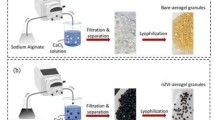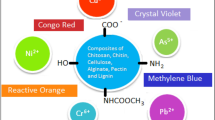Abstract
Synthesis of sodium alginate-g-poly(acrylamide-co-N-methylacrylamide) [S-III], sodium alginate-g-poly(N-methylacrylamide-co-N,N-dimethylacrylamide) [S-II], sodium alginate-g-poly(acrylamide-co-N,N-dimethylacrylamide) [S-I]. Sodium alginate-g-poly(N,N-dimethylacrylamide) [SAG-g-PDMA] and sodium alginate-g-poly(acrylamide) [SAG-g-PAM] were prepared by solution polymerization technique using potassium peroxydisulfate as the initiator at 70 °C in water medium. The graft copolymers were characterized by FTIR and NMR (1H and 13C) spectroscopy, SEM and XRD studies. All the five graft copolymers were used to remove Pb(II) ions from the aqueous solution and also in flocculation studies of kaolin clay (1.0 wt%), silica (1.0 wt%) and iron ore slime (0.25 wt%) suspensions. A comparative studies of all the five graft copolymers were also made in both the two cases. The Pb(II) ion removal capacity of all the graft copolymers follows the order S-III > SAG-g-PAM > S-II > SAG-g-PDMA > S-I. But the flocculation performance of the graft copolymers follows the order S-II > S-I > S-III > SAG-g-PDMA > SAG-g-PAM. S-III was also used for the competitive metal ion removal with Hg(II), Cd(II), Cu(II) and Zn(II). Pb(II) adsorption of S-III (the best Pb(II) ion adsorber) follows pseudo second order rate equation and Langmuir adsorption isotherm.









Similar content being viewed by others
References
Kumar PS (2013) Environ Prog Sustain Energy 33:55–64
Wang I, Zhang J, Ahao R, Li Y, Zhang C (2010) Bioresour Technol 101:5808–5814
Deblonde T, Cossu-Leguille C, Hantemann P (2011) Int J Hyg Environ Health 214:442–448
Knoig TN, Shulami S, Rytwo G (2012) Appl Clay Sci 67–68:119–124
Balasubramanian R, Perumal SV, Vijayaraghavan K (2009) Ind Eng Chem Res 48:2093–2099
King P, Rakesh N, Beenalahari S, Kumar Y, Prasad VSRK (2007) J Hazard Mater 142:340–347
Keles E, Ozer AK, Yoruk S (2010) Desalination 253:124–128
Santhy K, Selvapathy P (2004) Sep Sci Technol 39:3331–3351
Rivas BL, Pereira ED, Moreno- Villoslada I (2003) Prog Polym Sci 28:173–208
Rivas RL, Villoslade-moreno I (1998) Macromol Chem Phys 199:1153–1160
Kolya H, Tripathy T (2013) Int J Biomacrmol 62:557–564
Sasmal D, Singh RP, Tripathy T (2015) Colloid Surface A 482:575–584
Kolya H, Tripathy T (2015) Polym Int 64:1336–1351
Luo X, Liu L, Deng F, Luo S (2013) J Mater Chem A 1:8280–8286
Kanwal F, Rehman R, Anwar J, Saeed M (2013) Asian J Chem 25:2399–2404
Bratby J (1980) Coagulation and Flocculation, Chap. 8. Uplands Press, Clayden
Girma KB, Lorenz V, Blaurock S, Edelman FT (2005) Coord Chem Rev 249:1283–1293
Clayden J, Greeves N, Waren S, Wothers P (2001) Organic chemistry. Oxford University Press, Oxford, p 293
Crini G, Peinday NH, Gimbert F, Robert C (2007) Sep Purif Technol 53:97–110
Langmuir I (1918) J Am Chem Soc 40(9):1361–1403
Mackay G (1982) J Chem Technol Biotechnol 32(7–12):759–772
Gueu S, Yao B, Adouby K, Ado G (2007) Int J Environ Sci Technol 4:11–17
M. A. K. Hanaflash, Ibrahim SC, M. Z. A. Yahya (2006) J Appl Sci Res 2:1169–1174
Gupta VK, Ali I (2004) J Collid Interface Sci 271:321–328
Dicninson E, Erikson I (1991) Adv Colloid Interface Sci, 34:1–2
R. P. Singh, Advance turbulent drag reducing and flocculating materials based on polysaccharides (1995), in: P. N. Prasad, J. E. Mark, T. J. Fai (Eds). Polymers and other advance materials, emerging technologies buisiness opportunities. Plenum Press, New York, pp 227–249
Brostow W, Pal S, Singh RP (2007) Mater Lett 61:4381–4384
Kulicke WM, Knievrske R, Klein J (1982) Prog Polym Sci 8:373–468
Acknowledgements
Financial support from Department of Science and Technology (DST), Govt. of West Bengal [868 (sanc)/ST/P/S & T/15G-9/2015 dated 15.01.2016] for carrying out the research work in earnestly acknowledged.
Author information
Authors and Affiliations
Corresponding author
Rights and permissions
About this article
Cite this article
Tripathy, T., Kolya, H. & Jana, S. Selective Lead(II) Adsorption and Flocculation Characteristics of the Grafted Sodium Alginate: A Comparative Study. J Polym Environ 26, 926–937 (2018). https://doi.org/10.1007/s10924-017-1004-7
Published:
Issue Date:
DOI: https://doi.org/10.1007/s10924-017-1004-7




